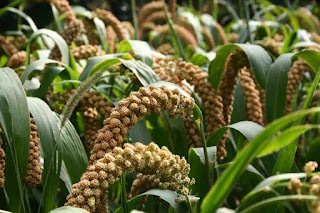MILLETS AS SUSTAINABLE FOOD SOURCE FOR FUTURE
With an aim to increase awareness of
the contribution of millets to our food security and nutrition that has guided civilizations
of the world to the path of progress and prosperity and to highlight its
potential for addressing the global scourge of hunger and starvation for a
sustainable economy, the World Food and Agriculture Organisation (FAO) endorsed
a proposal received from India to celebrate its importance on a global scale
and, accordingly, the United Nation's
General Assembly declared the year 2023 as the International Year of Millets
(IYM).
As
the poor and developing countries of the world struggle to feed their ever-growing
population afflicted with hunger and malnutrition, cereal crops like millet
provide an affordable and nutritious solution. Millets can grow on arid lands with minimal capital inputs
and are resilient to disease, drought and changes in climate. They don't even
require the application of fertilizers. Large-scale millet production
can support the lives and livelihoods of small-holder farmers and can provide
jobs to millions of women and youth of these countries for sustainable growth
and decent living. As rightly said by the FAO Director General QU Dongyu at the
opening ceremony of the IYM on 2nd December, 2022, 'Millets are incredible
ancestral crops with high nutritional value. Millets can play an important role
and contribute to our collective efforts to empower smallholder farmers,
achieve sustainable development, eliminate hunger, adapt to climate change,
promote biodiversity, and transform agri-food systems.'
Millet is a
collective term referring to a number of small-grained, annual cereal crops belonging
to the grass family primarily cultivated on marginal lands in dry areas of
temperate, subtropical and tropical regions of the world. They are commonly
used as food for humans and fodder. They are highly tolerant to drought and other extreme weather conditions
and have even greater nutrient value than the common cereals in use. Though
various species of millet were initially domesticated in different parts of the
world most notably East Asia, South Asia, West Africa and East Africa, they
have eventually spread well beyond their original limits. They are now
important sources of nourishment for millions of people in sub-Saharan Africa
and Asia. They are deeply rooted in the culture and traditions of indigenous
people of these regions since time immemorial as various festivals and rituals
are often associated with the cultivation and consumption of millets.
Millets have
been an integral part of our diet for centuries. The earliest evidence of
millet has been found in the Indus Valley civilization and was probably one of
the first plants to be domesticated by people for food. Various types of millets were mentioned in some of
our ancient texts like the Yajurveda under the
name Priyaṅgu
(Foxtail millet), Aṇu (Barnyard
millet) and Syāmāka (Black finger
millet) indicating that
millet cultivation was practised around 3000
BCE in India. Some of the common millets now cultivated in
India are Jowar (Sorghum), Ragi (Finger millet), Korra (Foxtail millet), Arke
(Kodo millet), Sama (Little millet), Bajra (Pearl millet), Chena/Barr (Proso
millet) and Sanwa (Barnyard millet). In India, millets are
generally cultivated mostly in tribal-dominated mountainous areas of the states
of Haryana, Uttar Pradesh, Chhattisgarh, Gujarat, Rajasthan, Madhya Pradesh,
Maharashtra, Andhra Pradesh, Karnataka, Tamil Nadu and Telangana. Over the past five years, Odisha has recorded a
14-fold increase in millet production, from 3,333 ha in 2017-18 to 53,230 ha in 2021-22 because of
sustainable agricultural practices and quality seeds.
Millet is grown in about 131 countries
worldwide and is the traditional food for around 60 crore people in Asia and
Africa. India, Nigeria and China are the chief producers of millet in the
world, accounting for more than 55% of the global production with India itself
being the largest producer in the world sharing 20% of the global production
and 80% of Asia’s production. Millets are nutritionally superior to other
cereals like wheat, rice and maize owing to their higher protein levels and
more balanced amino acid profile. Millet also contains various phytochemicals
which exert therapeutic properties owing to their anti-inflammatory and
anti-oxidative nature. Further, millet grains are rich sources of nutrients
like carbohydrates, dietary fibre, and high-quality fat and minerals like
calcium, potassium, magnesium, iron, manganese, zinc and vitamins like B
complex. For example, Ragi is known to
have the highest Calcium content among all the food grains found in nature.
Millet can provide nutritional security and act as a shield against nutritional
deficiency diseases like Kwashiorkor and Marasmus, especially among children
and women. Its high Iron content can fight the high prevalence of anaemia in
India in infants and women of reproductive age. Millets can also help tackle
various lifestyle related health challenges like obesity and diabetes as they
are gluten-free and have a low glycemic index and, hence, are capable of reducing the risk of heart
disease and high blood pressure.
To boost millet production in India,
the government has taken a number of initiatives by hiking the Minimum Support
Price of course grains and including its steady supply in the public
distribution chain. However, the measures taken by various governments around
the world are minuscule by far and a lot more is to be done in this regard to realize
the full potential of this wonder crop. Extensive research should be undertaken
to find high-yielding and high resilient varieties of the crop for ensuring its
compatibility and versatility under diverse climatic conditions of the
world. The declaration of the
International Year of Millets will further glorify the role of millets in our
daily life as an affordable and sustainable source of food ushering in a new
era of a hunger-free world.
Nikunja Bihari Sahu
Education Officer
Regional Science Centre
Bhopal





Comments
Post a Comment